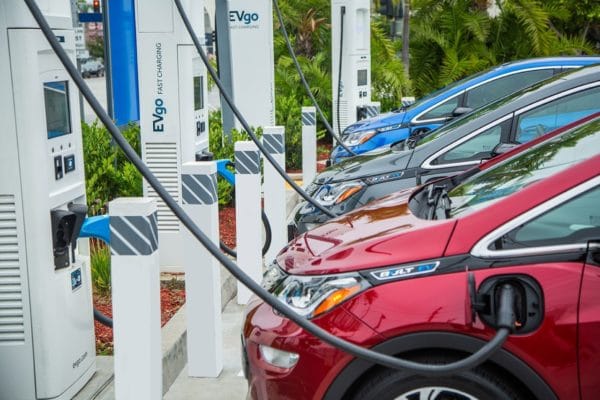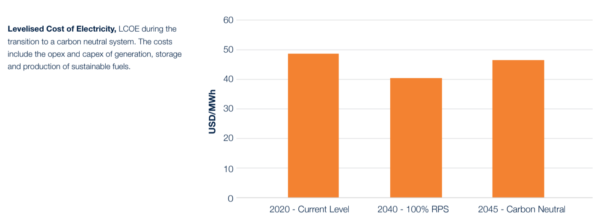A new study, “Front-loading Net Zero,” by Wärtsilä Energy, shows that front-loading and accelerating the introduction of renewable energy to create a 100% carbon neutral grid in California by 2040 – five years before the state’s RPS calls for a 100% carbon neutral grid – could cut the state’s cost of electricity generation by 17%.
According to authors Antti Alahäivälä and Dr. Karl Meeusen, both of Wärtsilä Energy, the state’s historic status as an American renewable energy pioneer, as well as the plummeting costs of renewable generation, have created a situation where electricity prices in a future 100% renewable energy system will be lower than they are today.
This reality, however, is not one that the state is on pace to achieve. The report models the renewable capacity additions and total resource restructuring necessary to achieve the vision, which includes:
- A 300% increase in wind capacity, from 10 GW in 2020 to 40 GW in 2045
- A 276% increase in solar PV capacity, from 29 GW in 2020 to 109 GW in 2045
- An 800% increase in energy storage capacity, from 4 GW in 2020 to 36 GW in 2045,
To reach these figures, the study finds that an average of 3.2 GW of solar PV and 1.2 GW of wind must be added every year to reach these targets. That is significantly more than California’s current record of 2.7 GW of non-rooftop solar power or 1 GW of wind power in a single year.

There is also the issue of MW needed vs. MWh needed, which Wärtsilä also modeled for. California’s 2045 forecasted peak load is only expected to increase 23%, from 57 GW to 70 GW, but the overall TWh of consumption will increase 50%, from 280 TWh to 420 TWh by 2045. This growth and apparent imbalance is driven societal electrification, which includes, electric vehicles and the production of sustainable fuels from wind and solar PV.
Outside of what is listed, the authors argued that California needs additional resources in supplement; specifically, current baseload resources must be replaced by faster, more flexible resources that are capable of running on sustainable fuels.
Such sustainable fuels, produced by excess wind and solar energy, plus storage resources, can enable California to cleanly and reliably shift energy from low-net loads, when power demand is low and wind and solar energy production are at their highest, to high-net loads, when renewable generation is at its lowest and demand is highest, according to the authors.
This transition will require careful planning, beyond just creating a stack of capacity, comparing the stack to forecasted peak load, and building more if there is not enough capacity to serve the load. Using the state’s summer 2020 rolling blackouts as a backdrop the authors argued that there needs to be both enough reliable capacity to meet the peak and that the resources work symbiotically to ensure adequate energy is available during all hours.
As for how a front-loaded scenario can still be less expensive than the current RPS, the authors outlined that it all comes down to reductions in fossil fuels, which currently serve as baseload. During the transition to carbon neutrality, the electricity produced by these fossil sources would be replaced by economic solar PV and wind generation, which are falling in price annually. The affordable energy from renewables, paired battery storage and long-term sustainable fuel energy storage, enable a cost optimal power system with lower generation costs.

Much of the analysis leans on deploying significant amounts of long-duration energy storage to meet daily ramping needs and energy requirements and the use of hydrogen-based sustainable fuels created from excess renewable energy. The authors predicted that these fuels could bridge up to 20% of gaps in power delivery and load meeting, so long as planning for their inclusion and investment in their development is done right away. The report targets 2030 as the year these resources need to start playing a major role in the energy mix.
With all resources accounted for, the report models that a 2040 zero-carbon California grid would include 53% solar, 30% wind, 17% energy storage, 7% hydro, 7% mixed additional resources, and 3% natural gas.
This content is protected by copyright and may not be reused. If you want to cooperate with us and would like to reuse some of our content, please contact: editors@pv-magazine.com.









Seems like a good summary of the Wärtsilä Energy report until the carbon neutral generation summary includes 3% natural gas!? We are missing a crucial paragraph explaining how that is made carbon neutral!